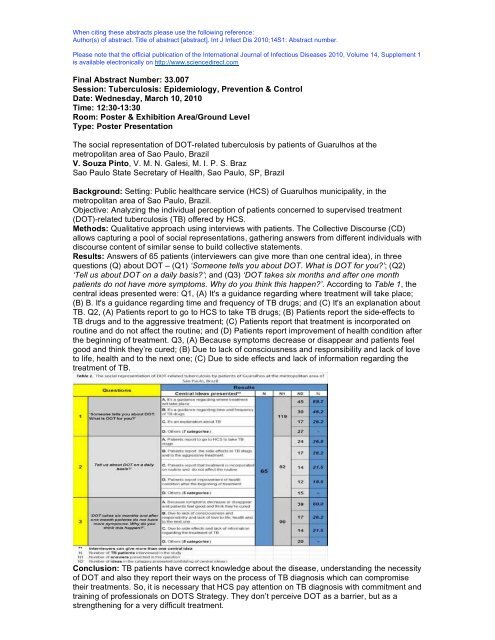14th ICID - Poster Abstracts - International Society for Infectious ...
14th ICID - Poster Abstracts - International Society for Infectious ...
14th ICID - Poster Abstracts - International Society for Infectious ...
You also want an ePaper? Increase the reach of your titles
YUMPU automatically turns print PDFs into web optimized ePapers that Google loves.
When citing these abstracts please use the following reference:<br />
Author(s) of abstract. Title of abstract [abstract]. Int J Infect Dis 2010;14S1: Abstract number.<br />
Please note that the official publication of the <strong>International</strong> Journal of <strong>Infectious</strong> Diseases 2010, Volume 14, Supplement 1<br />
is available electronically on http://www.sciencedirect.com<br />
Final Abstract Number: 33.007<br />
Session: Tuberculosis: Epidemiology, Prevention & Control<br />
Date: Wednesday, March 10, 2010<br />
Time: 12:30-13:30<br />
Room: <strong>Poster</strong> & Exhibition Area/Ground Level<br />
Type: <strong>Poster</strong> Presentation<br />
The social representation of DOT-related tuberculosis by patients of Guarulhos at the<br />
metropolitan area of Sao Paulo, Brazil<br />
V. Souza Pinto, V. M. N. Galesi, M. I. P. S. Braz<br />
Sao Paulo State Secretary of Health, Sao Paulo, SP, Brazil<br />
Background: Setting: Public healthcare service (HCS) of Guarulhos municipality, in the<br />
metropolitan area of Sao Paulo, Brazil.<br />
Objective: Analyzing the individual perception of patients concerned to supervised treatment<br />
(DOT)-related tuberculosis (TB) offered by HCS.<br />
Methods: Qualitative approach using interviews with patients. The Collective Discourse (CD)<br />
allows capturing a pool of social representations, gathering answers from different individuals with<br />
discourse content of similar sense to build collective statements.<br />
Results: Answers of 65 patients (interviewers can give more than one central idea), in three<br />
questions (Q) about DOT – (Q1) ‘Someone tells you about DOT. What is DOT <strong>for</strong> you?’; (Q2)<br />
‘Tell us about DOT on a daily basis?’; and (Q3) ‘DOT takes six months and after one month<br />
patients do not have more symptoms. Why do you think this happen?’. According to Table 1, the<br />
central ideas presented were: Q1, (A) It's a guidance regarding where treatment will take place;<br />
(B) B. It's a guidance regarding time and frequency of TB drugs; and (C) It's an explanation about<br />
TB. Q2, (A) Patients report to go to HCS to take TB drugs; (B) Patients report the side-effects to<br />
TB drugs and to the aggressive treatment; (C) Patients report that treatment is incorporated on<br />
routine and do not affect the routine; and (D) Patients report improvement of health condition after<br />
the beginning of treatment. Q3, (A) Because symptoms decrease or disappear and patients feel<br />
good and think they’re cured; (B) Due to lack of consciousness and responsibility and lack of love<br />
to life, health and to the next one; (C) Due to side effects and lack of in<strong>for</strong>mation regarding the<br />
treatment of TB.<br />
Conclusion: TB patients have correct knowledge about the disease, understanding the necessity<br />
of DOT and also they report their ways on the process of TB diagnosis which can compromise<br />
their treatments. So, it is necessary that HCS pay attention on TB diagnosis with commitment and<br />
training of professionals on DOTS Strategy. They don’t perceive DOT as a barrier, but as a<br />
strengthening <strong>for</strong> a very difficult treatment.
















